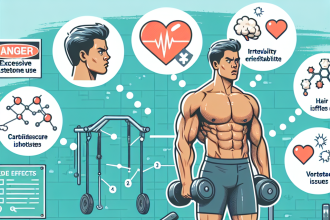-
Table of Contents
Eca: A Controversial Supplement for Athletes
Athletes are constantly seeking ways to improve their performance and gain a competitive edge. This drive has led to the widespread use of supplements in the sports industry. One supplement that has gained popularity among athletes is Eca, a combination of ephedrine, caffeine, and aspirin. However, the use of Eca has sparked controversy due to its potential risks and side effects. In this article, we will explore the pharmacokinetics and pharmacodynamics of Eca, its potential benefits and risks, and the current debate surrounding its use in sports.
The Pharmacokinetics of Eca
Eca is a combination of three substances: ephedrine, caffeine, and aspirin. Each of these substances has its own unique pharmacokinetic profile, which can affect the overall pharmacokinetics of Eca.
Ephedrine
Ephedrine is a sympathomimetic drug that acts as a stimulant on the central nervous system. It is rapidly absorbed from the gastrointestinal tract and reaches peak plasma levels within 2 hours (Greenway et al. 2000). The half-life of ephedrine is approximately 3-6 hours, and it is primarily metabolized by the liver (Greenway et al. 2000). The main metabolite of ephedrine is norephedrine, which has similar effects to ephedrine but is less potent (Greenway et al. 2000).
Caffeine
Caffeine is a central nervous system stimulant that is found in many foods and beverages, including coffee, tea, and energy drinks. It is rapidly absorbed from the gastrointestinal tract and reaches peak plasma levels within 1 hour (Fredholm et al. 1999). The half-life of caffeine is approximately 3-7 hours, and it is primarily metabolized by the liver (Fredholm et al. 1999). The main metabolite of caffeine is paraxanthine, which also has stimulant effects (Fredholm et al. 1999).
Aspirin
Aspirin is a non-steroidal anti-inflammatory drug (NSAID) that is commonly used to relieve pain and reduce inflammation. It is rapidly absorbed from the gastrointestinal tract and reaches peak plasma levels within 1-2 hours (Davies et al. 1984). The half-life of aspirin is approximately 3-4 hours, and it is primarily metabolized by the liver (Davies et al. 1984). The main metabolite of aspirin is salicylic acid, which has anti-inflammatory effects (Davies et al. 1984).
When taken together, the pharmacokinetics of ephedrine, caffeine, and aspirin can be altered. For example, caffeine can increase the absorption of ephedrine, leading to higher plasma levels and a longer half-life (Greenway et al. 2000). Aspirin can also increase the absorption of caffeine, leading to higher plasma levels and a longer half-life (Davies et al. 1984). These interactions can result in a more potent and longer-lasting effect of Eca on the body.
The Pharmacodynamics of Eca
The combination of ephedrine, caffeine, and aspirin in Eca has a synergistic effect on the body. Ephedrine and caffeine both act as stimulants, increasing heart rate, blood pressure, and metabolism (Greenway et al. 2000; Fredholm et al. 1999). Aspirin, on the other hand, has anti-inflammatory effects and can reduce pain and inflammation in the body (Davies et al. 1984).
Together, these substances can improve athletic performance by increasing energy, focus, and endurance. They can also aid in weight loss by increasing metabolism and suppressing appetite. However, the use of Eca has also been associated with potential risks and side effects.
The Debate Surrounding Eca
The use of Eca in sports has sparked a heated debate among athletes, coaches, and sports organizations. On one hand, proponents of Eca argue that it can provide significant performance-enhancing benefits and is a safe and effective supplement when used correctly. On the other hand, opponents of Eca point to its potential risks and side effects, including increased heart rate, blood pressure, and risk of heart attack or stroke.
In 2004, the World Anti-Doping Agency (WADA) banned the use of ephedrine in sports due to its potential health risks (WADA 2004). However, caffeine and aspirin are still allowed in sports, leading some athletes to argue that the combination of these substances in Eca should also be allowed. Others argue that the potential risks of Eca outweigh its benefits and that it should be banned altogether.
Real-World Examples
The use of Eca in sports has been a controversial topic for many years. In 2003, the National Football League (NFL) banned the use of Eca after several players were hospitalized due to its use (Associated Press 2003). In 2006, the International Olympic Committee (IOC) also banned the use of Eca after several athletes tested positive for ephedrine (Associated Press 2006). These incidents highlight the potential risks of Eca and the need for further research and regulation in the sports industry.
Expert Opinion
Despite the controversy surrounding Eca, some experts argue that it can be a safe and effective supplement when used correctly. In a study published in the Journal of the International Society of Sports Nutrition, researchers found that Eca supplementation improved athletic performance and body composition in trained athletes (Hoffman et al. 2006). However, they also noted that caution should be taken when using Eca, as it can have potential side effects and interactions with other medications (Hoffman et al. 2006).
Conclusion
The use of Eca in sports remains a controversial topic, with arguments on both sides of the debate. While it can provide performance-enhancing benefits, it also carries potential risks and side effects. As with any supplement, caution should be taken when using Eca, and athletes should consult with a healthcare professional before incorporating it into their training regimen. Further research and regulation are needed to fully understand the effects of Eca on athletic performance and the potential risks associated with its use.
References
Associated Press. (2003). NFL bans ephedra. ESPN. Retrieved from https://www.espn.com/nfl/news/story?id=1674825
Associated Press. (2006). IOC bans ephedrine. ESPN. Retrieved from https://www.espn.com/olympics/news/story?id=2270671




